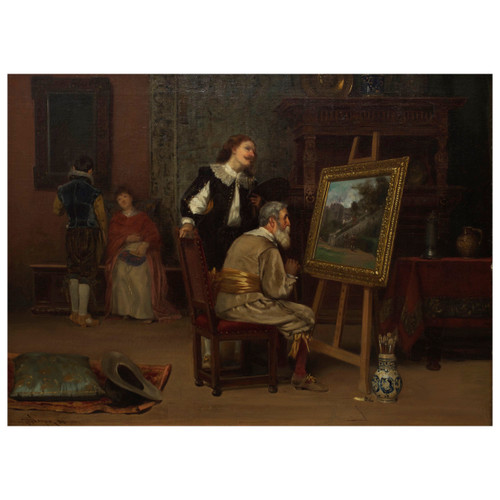catalog text
"THE ART CRITIC" (1886) BY JOHN HENRY DOLPH (AMERICAN, 1835-1903)
Executed in oil on canvas, signed lower left "J.H. Dolph 86"
Item # 012GPP08A
A humorous look at the relationship between the artist and his patron, Dolph provides a historical context to this timeless moment by rooting it in the late medieval with period correct attention to even the smallest details. The patron stands over the shoulder of the seated artist, his head twisted as he examines the landscape from all angles, perhaps looking for some small adjustments as the aged artist has his brush at the ready. Typical of Dolph, the work shows an extraordinary ability to capture even minute aspects of a moment with his brush; the tiny landscape painting is clear enough to show two figures conversing below a descending stone staircase before a castle on a tailored lawn. Likewise, the rich textures of the fabrics, pottery elements, tapestry and tablecloths as well as the garments show a certain culmination of Dolph's still-life studies. The scene is signed in his typical script with a conjoined J and H in a reverse slant with a date of 1886.
Born in Fort Ann, New York in 1835, John Henry Dolph and his mother lived in Ashtabula County, Ohio. He left home at the age of fourteen after the death of his mother, first making a living by decorating carriages and coaches before studying with Allen Smith of Cleveland, Ohio in 1855. He moved to Detroit, where he pursued portrait paintings for a few years before moving to New York City in 1863. Around 1870 he traveled to Antwerp to study under the noted animal painter Louis Van Kuyck. He also spent time studying in Paris for two years while also working in Rome.
Upon returning to the United States, Dolph demonstrated his range and versatility, painting wonderful landscape paintings of the Hudson Valley, still-life paintings and domestic genre scenes. He turned his focus for a time to farmyard animal paintings, but became somewhat tired of the subject matter as the market for the work was not very good.
In 1875 a major turning point in his career came about, as he discusses in 1898 with the magazine Photo-Beacon, when he was short on rent funds and had to resort to sending various belongings to auction. Among them was an empty frame that he purchased for $ 15. Hoping to recoup the $ 15, but having nothing to fill the frame with, he painted a cat that had just walked into the room. At the auction, this painting ended up selling for $ 85 and Dolph recounts "By the gods, if the people want cats, they shall have cats!". Thereafter he focused a majority of his work on depictions of cats and their humorous interactions, becoming known as one of the foremost American painters of cats.
While in New York, he and his wife Mary divided their time between a summer cottage they maintained in Bellport, Long Island by the water and his studio in Manhattan.
Dolph became an associate member of the National Academy of Design in 1877 and a full member in 1898. There he was an active exhibitor starting in 1864 and continuing almost every year including three paintings the year of his death in 1903; he only missed the event in 1871 and 1881 while he was in Europe. He exhibited at the Paris Salon of 1882, the 1889 Exposition Universelle in Paris, the Art Institute of Chicago, the Pennsylvania Academy of Fine Arts, the 1901 Pan-American Exposition in Buffalo, the Boston Art Club, the Brooklyn Art Association and the Lotus Club. He was also an active member of the Salmagundi Club and helped organize the Society of American Artists. His works are held in the collections of in the Whitney Museum of American Art, the Portland Art Museum and the Newark Museum.
Artist Listings & Bibliography:
- E. Benezit Dictionary of Artists, Vol. IV, Gründ, 2006, p. 1016
- The Annual Exhibition Record of the National Academy of Design
- The National Academy of Design Exhibition Record, 1861-1900
Provenance:
- Christies, New York, (label retained verso)
- Newman Galleries, Philadelphia, Pennsylvania (two labels retained verso)
- Private Collection, Philadelphia
Measurements: 24 3/8" H x 30 1/2" W [frame]; 18 1/8" H x 24 1/4" W [canvas]
Condition Report:
A clean and vibrant surface; appears to have been conserved in the last thirty years at which point it was relined - chalk notation on back of frame 1/23/89 perhaps correlates to the time of conservation, or would at least be in the likely range of it. Very faint stretcher impressions along the edges of the painting. Minor surface craquelure. Under UV presence of later varnish flares somewhat across the surface and makes a clear reading difficult; extreme edges with inpainting to losses from frame rubbing; lower extreme edge with a 1" spot of inpainting just below the artist's foot; leg of the table far right with inpainting; approx. 1" square of inpainting in lower right corner just below shadow of the table; for a full and exhaustive description of the surface under UV, please request the close up UV images.
























